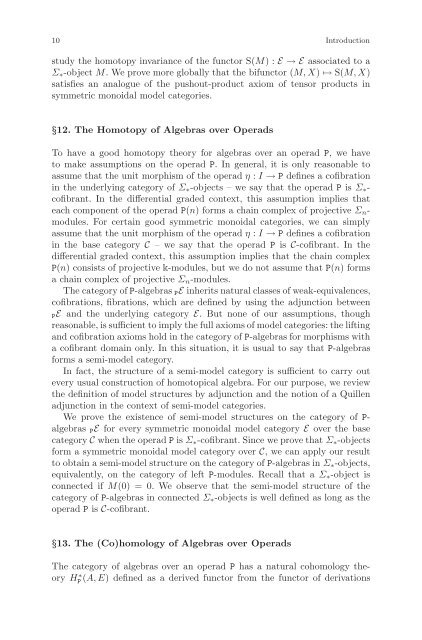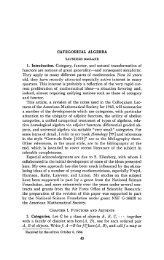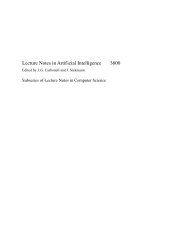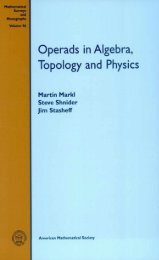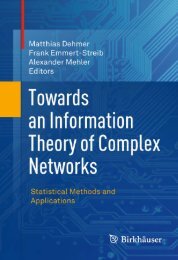Symmetric Monoidal Categories for Operads - Index of
Symmetric Monoidal Categories for Operads - Index of
Symmetric Monoidal Categories for Operads - Index of
You also want an ePaper? Increase the reach of your titles
YUMPU automatically turns print PDFs into web optimized ePapers that Google loves.
10 Introduction<br />
study the homotopy invariance <strong>of</strong> the functor S(M) :E→Eassociated to a<br />
Σ∗-object M. We prove more globally that the bifunctor (M,X) ↦→ S(M,X)<br />
satisfies an analogue <strong>of</strong> the pushout-product axiom <strong>of</strong> tensor products in<br />
symmetric monoidal model categories.<br />
§12. The Homotopy <strong>of</strong> Algebras over <strong>Operads</strong><br />
To have a good homotopy theory <strong>for</strong> algebras over an operad P, wehave<br />
to make assumptions on the operad P. In general, it is only reasonable to<br />
assume that the unit morphism <strong>of</strong> the operad η : I → P defines a c<strong>of</strong>ibration<br />
in the underlying category <strong>of</strong> Σ∗-objects – we say that the operad P is Σ∗c<strong>of</strong>ibrant.<br />
In the differential graded context, this assumption implies that<br />
each component <strong>of</strong> the operad P(n) <strong>for</strong>ms a chain complex <strong>of</strong> projective Σnmodules.<br />
For certain good symmetric monoidal categories, we can simply<br />
assume that the unit morphism <strong>of</strong> the operad η : I → P defines a c<strong>of</strong>ibration<br />
in the base category C – we say that the operad P is C-c<strong>of</strong>ibrant. In the<br />
differential graded context, this assumption implies that the chain complex<br />
P(n) consists <strong>of</strong> projective k-modules, but we do not assume that P(n) <strong>for</strong>ms<br />
a chain complex <strong>of</strong> projective Σn-modules.<br />
The category <strong>of</strong> P-algebras PE inherits natural classes <strong>of</strong> weak-equivalences,<br />
c<strong>of</strong>ibrations, fibrations, which are defined by using the adjunction between<br />
PE and the underlying category E. But none <strong>of</strong> our assumptions, though<br />
reasonable, is sufficient to imply the full axioms <strong>of</strong> model categories: the lifting<br />
and c<strong>of</strong>ibration axioms hold in the category <strong>of</strong> P-algebras <strong>for</strong> morphisms with<br />
a c<strong>of</strong>ibrant domain only. In this situation, it is usual to say that P-algebras<br />
<strong>for</strong>ms a semi-model category.<br />
In fact, the structure <strong>of</strong> a semi-model category is sufficient to carry out<br />
every usual construction <strong>of</strong> homotopical algebra. For our purpose, we review<br />
the definition <strong>of</strong> model structures by adjunction and the notion <strong>of</strong> a Quillen<br />
adjunction in the context <strong>of</strong> semi-model categories.<br />
We prove the existence <strong>of</strong> semi-model structures on the category <strong>of</strong> Palgebras<br />
PE <strong>for</strong> every symmetric monoidal model category E over the base<br />
category C when the operad P is Σ∗-c<strong>of</strong>ibrant. Since we prove that Σ∗-objects<br />
<strong>for</strong>m a symmetric monoidal model category over C, we can apply our result<br />
to obtain a semi-model structure on the category <strong>of</strong> P-algebras in Σ∗-objects,<br />
equivalently, on the category <strong>of</strong> left P-modules. Recall that a Σ∗-object is<br />
connected if M(0) = 0. We observe that the semi-model structure <strong>of</strong> the<br />
category <strong>of</strong> P-algebras in connected Σ∗-objects is well defined as long as the<br />
operad P is C-c<strong>of</strong>ibrant.<br />
§13. The (Co)homology <strong>of</strong> Algebras over <strong>Operads</strong><br />
The category <strong>of</strong> algebras over an operad P has a natural cohomology theory<br />
H∗ P (A, E) defined as a derived functor from the functor <strong>of</strong> derivations


